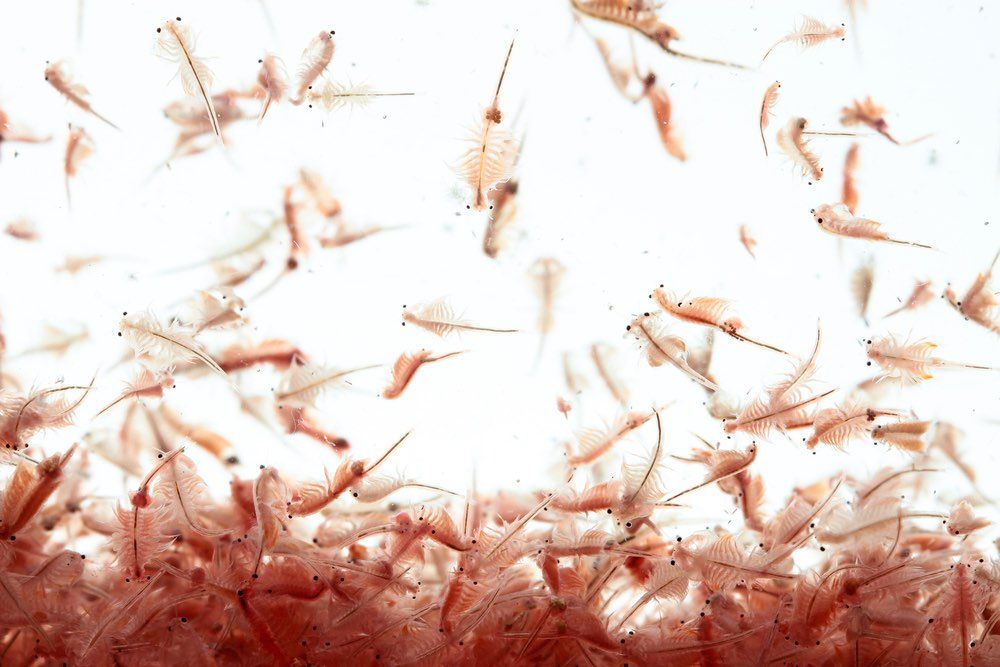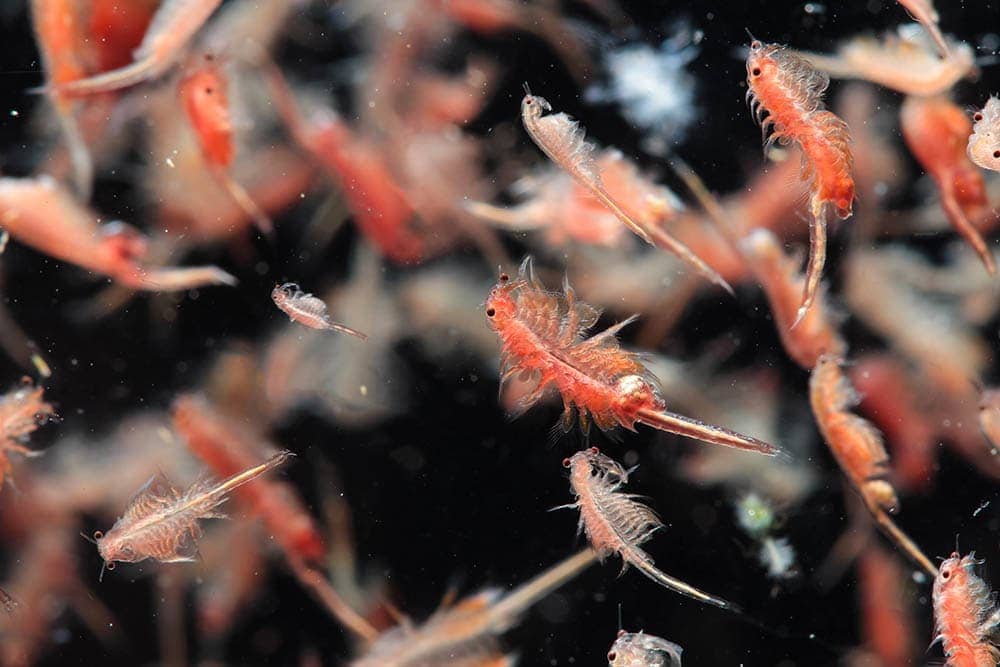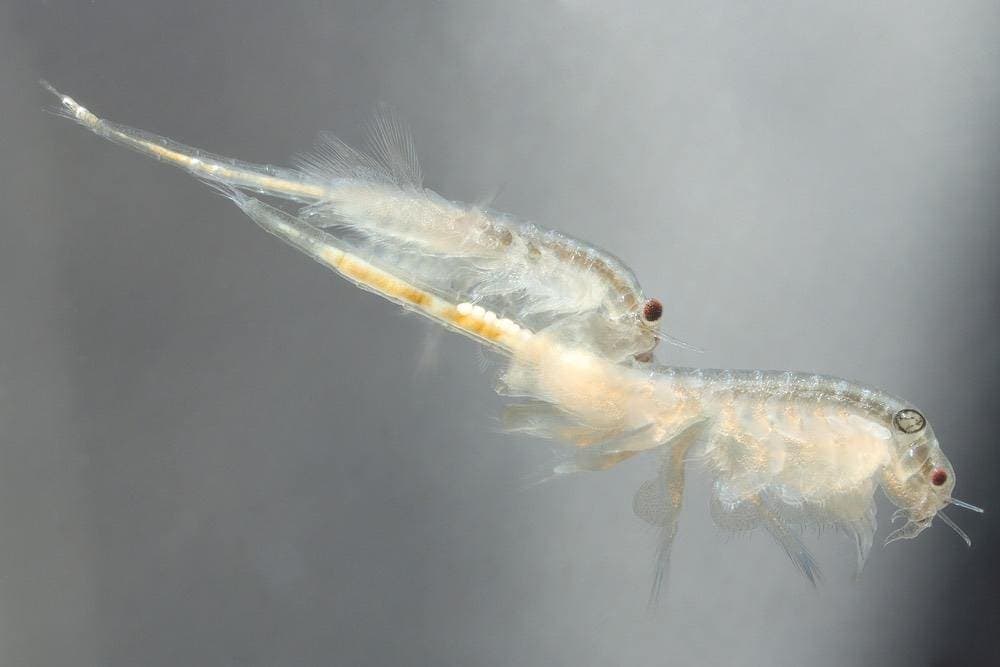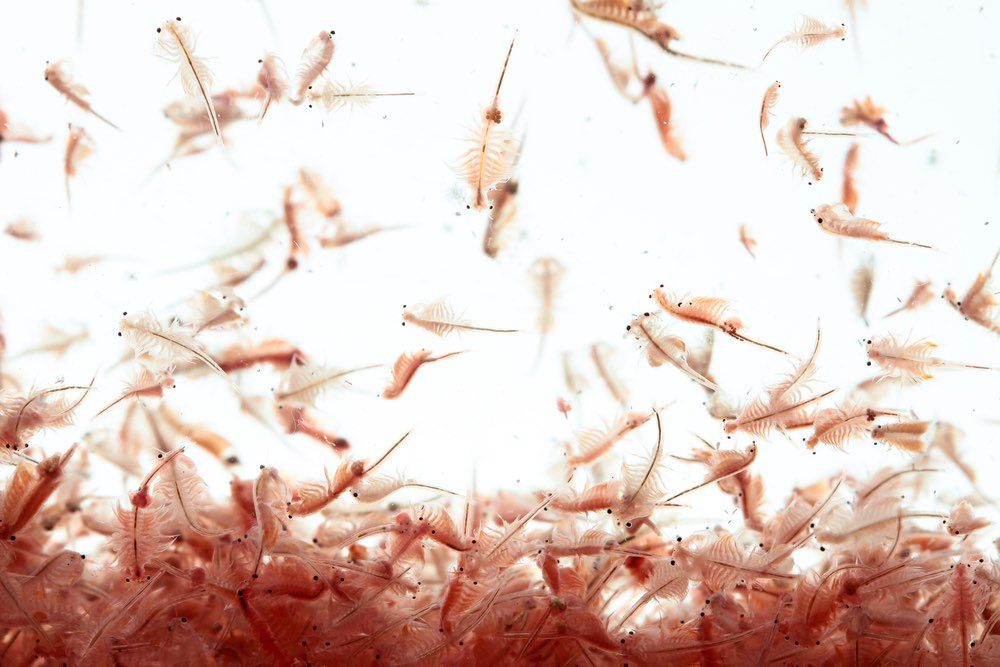What O Feed Baby Brine Shrimp to Grow

Brine shrimp is a great protein-rich supplement for nearly all species of fresh and saltwater fish alike. Most local fish stores will sell brine shrimp nauplii (baby brine shrimp) or their small brown eggs. Although purchasing from your local fish store sounds more hassle-free, baby brine shrimp will not be able to fill up larger fish such as goldfish or cichlids. Pet store brine shrimp is marketed to smaller carnivorous fish like Siamese fighting fish or Tetras.
Feeding live foods to fish has many benefits. Pet stores do not usually stock live brine shrimp, with the closest brine shrimp size suitable for a larger fish being frozen or freeze-dried.
In this article, we will provide you with everything you need to know when it comes to growing out brine shrimp and feeding it to your larger fish.

What Are Brine Shrimp?

Brine shrimp are minuscule crustaceans at an average maximum size of 15 mm. The name can be misleading, as brine shrimp are not shrimp, but belong to the same family. They readily eat algae particles in the water. Interestingly, brine shrimp breathe through their legs and swim upside down. Female brine shrimp can produce offspring without the presence of a male. Brine shrimp take a particular liking to water high in salt content and naturally occur in salt-rich waters like salt lakes and the ocean.
To get brine shrimp to reproduce and be healthy for your fish, replicating their natural habitat will ensure they are growing and reproducing to the best of their ability.
Advantages of Brine Shrimp for Fish
- Rich protein source
- Offers enrichment when fed alive
- A constant supply of food
- Able to control the overall guaranteed analysis of the brine shrimp
- Grow the brine shrimp to the size you wish to use as fish food
Brine Shrimp Guaranteed Analysis
The overall GA is determined by what the brine shrimp were fed and how stress-free their grow-out conditions were.
We can expect the average brine shrimp to have the following percentages-
- 46–50% crude protein
- 4–8% crude fat
- 2–4% crude fiber
To summarise, brine shrimp are high in natural proteins, high in fat, and provide a decent amount of fiber for most species of fish.
Brine Shrimp Maturation Conditions
If you provide the brine shrimp with appropriate maturing conditions, you can expect to have your brine shrimp reach adulthood.
To successfully grow brine shrimp, you will need to prepare the following-
- Two large shallow containers or a 5–10-gallon aquarium (aerated lid is not required)
- A source of fresh saltwater
- An air pump and airstone on an exceptionally low setting
- Algae wafers or sinking pellets
Brine shrimp are not able to grow in water lacking salinity, you will need to have a constant supply of saltwater for your brine shrimp.
Setting Up the Container or Aquarium
- Fill the two shallow containers/aquarium with a fresh supply of saltwater. To achieve this, mix a solution of aquarium salt and dechlorinated freshwater in a dosage recommended by a knowledgeable fish store employee.
- The first setup will be for the eggs and hatchlings. The second setup is for the babies to be matured into fully grown adults.
- Keep the set up close to an outlet source so you can plug in an air pump. Attach airline tubing to a small low output air stone. It should be just enough to gently move the surface of the water.
- Add in a small uncomplicated fake plant for a hiding place.

How Long Do Brine Shrimp Take to Develop?
Brine shrimp will take approximately 3 weeks to fully develop into their adult state. The growth rate can be increased or decreased depending on the hatch rate, conditions, and appropriate food intake.
How to Hatch Brine Shrimp
Hatching these fascinating creatures is simple. The shrimp eggs are called cysts and usually have an incubation period of 24 hours. The cysts will take longer to hatch if the temperature is on the lower side. An option to promote faster hatching time, you can add in a heater if the room temperature is naturally low.
- Purchase premium brine shrimp cysts
- Store the cysts in cool conditions to increase the hatch rate
- Keep the eggs free of moisture and in an airtight container
- Hatch the brine shrimp in warm temperatures between 80°F to 82°F
- To trigger hatching, introduce the cysts to strong light for a few hours
- Keep the hatchery in a place that receives efficient light for optimal hatching results
The Brine Shrimp Hatchery & Harvesting
A hatchery is a place for the eggs to incubate until the brine shrimp hatch and should be moved to the grow-out container or aquarium.
To set up the hatchery, the following conditions bring out the best results:
- Mix saltwater with a pH above 8.0
- Attach an air stone into the hatchery
- Fill the container with 1 inch of fresh saltwater
- Add a teaspoon of the dried brine shrimp eggs into the water
- Soak the cysts for 20 minutes in the solution while moving them around to soak up moisture
- Turn the output on the air stones pump to ensure the cysts move constantly in the water and do not standstill
When the hatching is complete, turn off the air pump once the empty brown shells are floating. The live brine shrimp will appear to be tiny orange vibrating nauplii that will sit at the top of the waterline.
Catch the nauplii with an aquarium net and rinse them over the sink with a jug filled with fresh saltwater. Do not keep the shrimp out of the water for more than 5 seconds.
Proceed to place the nauplii in the fully set up grow-out container or aquarium.

How to Grow Out Brine Shrimp
- Feed the brine shrimp a natural diet replicating their natural food sources in the wild.
- Keep the conditions clean and well maintained
- Ensure enough aeration is happening via surface movement
- Keep the grow out container or aquarium within an ideal temperature and light requirements (moderate lighting, tropical temperatures)
Food Source for Brine Shrimp
In the wild, brine shrimp will consume microscopic algae particles found in the water. This may not be found in your household tap water and needs to be substituted by artificial means. Brine shrimp are only able to consume foods of particle sizes. Regular fish foods will not do the trick.
- Egg yolk
- Whey yeast
- Fry foods
- Soybean powder
- Wheat flour
- Dissolved algae wafer or pellets
- Fish meal
Maintenance
Keep the water clean by doing cautious water changes with a pantyhose over the entrance to the siphon. Adjusting the air stone to provide good surface movement will prevent the brine shrimp from suffocation.
Keep a thermometer in the grow-out set up to monitor the temperature. It is also a good idea to measure the salinity in the water using

Conclusion
Although a lengthy process, hatching and growing out brine shrimp for fish food has many advantages and benefits. Carnivorous fish can have a constant supply of protein-rich live foods. Overall, hatching and growing your brine shrimp saves you money in the long run. We hope this article has provided you with all the information you require to successfully start hatching your brine shrimp!
You might also like some of our top-trending posts:
- How to Build a DIY Aquarium in 15 Easy Steps
- Top 10 Best Saltwater Aquarium Fish Breeds (with Pictures)
- How to Raise Mosquito Larvae for Fish Food (Beginner's Guide)
Featured Image Credit: Napat, Shutterstock
Source: https://www.hepper.com/how-to-grow-brine-shrimp-for-fish-food/
0 Response to "What O Feed Baby Brine Shrimp to Grow"
Post a Comment